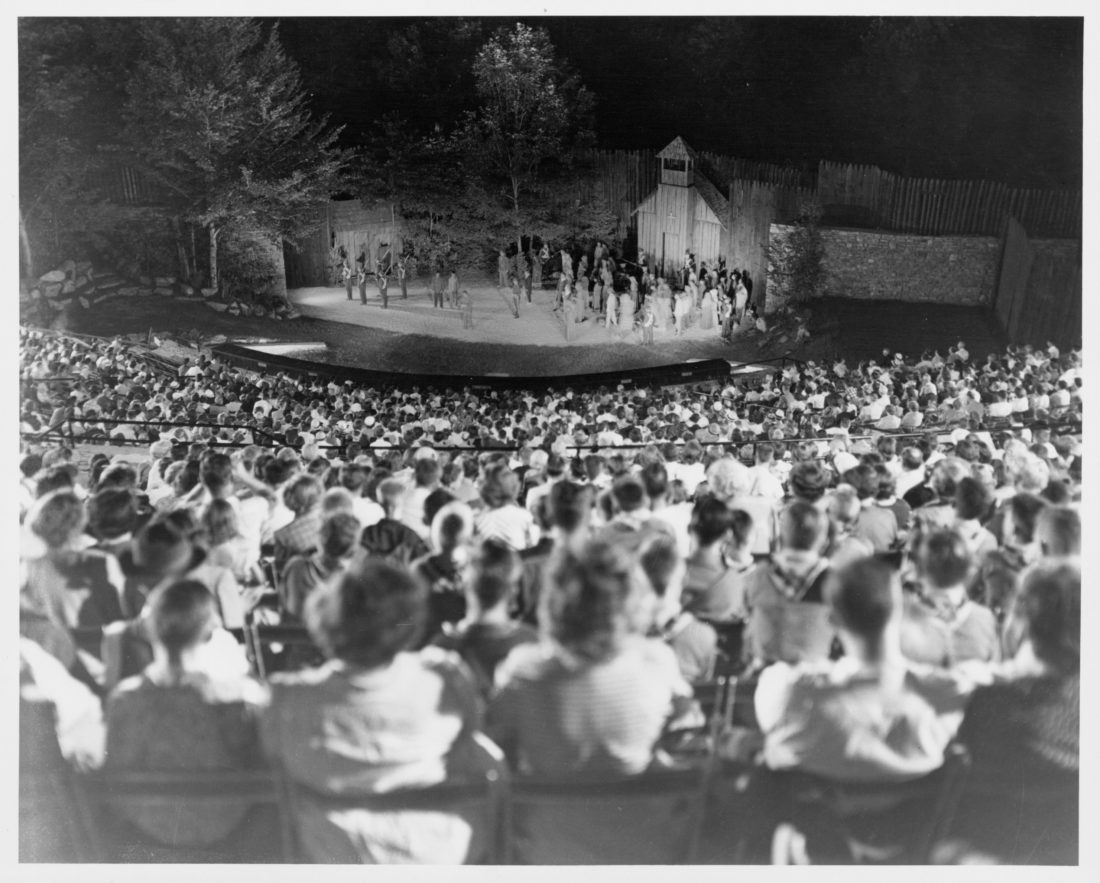In his 2018 book, New South Indians: Tribal Economics and the Eastern Band of Cherokee in the Twentieth Century, historian Christopher Arris Oakley notes that in 1945, more than 750,000 people visited Great Smoky Mountains National Park. Within a year, total visitation would climb to 1.2 million.
During this time, civic leaders across 11 counties (including Buncombe) formed the Western North Carolina Associated Communities. Among its many missions, the group was interested in increasing the region’s tourism industry by capitalizing on the area’s cultural resources. Soon after its formation, Oakley writes, the group discussed “the untapped economic potential of the Cherokee reservation.” This would lead to the founding of the Cherokee Historical Association in 1948.
For the next two years, the association dedicated itself to the development of a new historical drama. Written by Kermit Hunter, Unto These Hills debuted July 1, 1950, at the newly constructed Mountainside Theatre in Cherokee.
Anticipation for the production was apparent throughout the spring and summer leading up to opening night. On March 26, 1950, in the Sunday edition of the Asheville Citizen-Times, readers were informed that the amphitheater had been “hollowed out of a hill side and is surrounded by mountains which shut out the sights and sounds of civilization.”
The article asserted that Unto These Hills would resolve a major inconvenience for Cherokee visitors and a previous dilemma for the WNCAC — lack of evening entertainment. The newspaper wrote:
“Since nearly everyone has at least a casual, romantic interest in Indians, what could be of more general appeal than the dramatic story of the removal of the Cherokees, staged in the very mountains to which the remnant of the tribe fled, and where their descendants live today?”
On June 25, just a week before the production’s official launch, the Sunday edition of the Asheville Citizen-Times reported that a special Friday evening performance would be held for members of the Eastern Band of Cherokee Indians, along with employees of the U.S. Park Service, State Highway Patrol and Indian Agency.
Cherokee elder Carl Standing Deer would be among those in attendance, the paper noted. The tribal member was quoted in the June 25 piece, stating that his grandfather was among the estimated 1,000 Cherokees who resisted the federal government’s 1838 removal. “He didn’t want to leave his home,” Standing Deer says. “He said he liked to hear the birds sing, and he liked to see the fog in the coves early in the morning.”
Later, in the same article, Hunter, the production’s playwright, is also quoted, offering his thoughts on the significance of Unto These Hills:
“I suppose this is one of the few times that a production of this size has ever taken an actual drama from the American Indian theme and shown the viewpoint of the Indians themselves. Usually they show the efforts of the white pioneers to destroy the Indians.”
While the play’s leading roles were performed by white actors, Hunter went on to note that some of its supporting cast included members of the tribe. The Friday evening performance for the Cherokee audience, he continued, was crucial to the show’s success:
“We are especially anxious to see their reactions, to hear their comments, and to ask their opinions. The whole Cherokee nation has shown a wonderful spirit of cooperation from the very start. If we can take this theme which is so very near to their hearts and make it pleasing to them, we will feel that we have accomplished something important and lasting, apart from any consideration of the play as pure entertainment.”
Throughout July and August, local, regional and statewide reviews would appear in The Asheville Citizen. On July 3, the paper wrote, “High in the hills of the Qualla Reservation the white man is acquitting a debt and righting a wrong.” The piece proclaimed that the violence featured in Unto These Hills offered a more complete account of the Native American experience. “The truth often is brutal,” the review declared. “[H]ere is the record of the callous mistreatment of a noble race[.]”
The production was a major success. On Aug. 31, 1950, The Asheville Citizen reported that the season’s overall attendance totaled more than 100,000, with visitors coming from 45 states and 10 foreign countries. “[O]n several occasions it has been necessary to sell standing room to accommodate the crowd,” the article noted.
Unto These Hills remains in production, with performances offered throughout the summer at the Cherokee Mountainside Theatre.
Editor’s note: Peculiarities of spelling and punctuation are preserved from the original documents.



How has “Unto These Hills” changed over the years? Is it still a major attraction?
This is from Visit Cherokee North Carolina: “Since its debut on July 1, 1950, “Unto These Hills” has entertained over six million people, telling the Cherokees’ rich story from 1780 to the twenty-first century. And for the first time in over a decade, that original production—updated for cultural sensitivity and extra stage drama—is back.” Hope that answers your questions. Thanks for reading.
Here is a 1940’s “travelogue” film about Western NC – includes parts about Asheville and also Cherokee https://www.youtube.com/watch?v=pwTygG78ka4
That’s great. Thanks as always, Phillip.